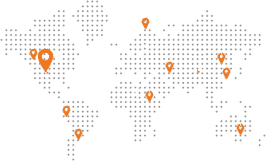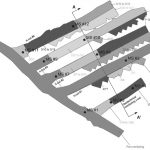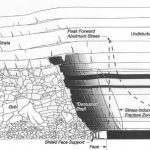41st U.S. Symposium on Rock Mechanics, Golden, Colorado, USA, July 17-21, 2006
Authors: B. Yu, L. J. Gilbride and J. F. T. Agapito (AAI)
Molycorp, Inc.’s Questa Mine plans to switch from gravity draw in Block 1 to a load-haul-dump (LHD) draw system in the East and West blocks of the D Orebody. Changes in mining method require modifying the support design. This paper summarizes the numerical modeling effort and findings in evaluating abutment stress conditions and ground support requirements for LHD mining. A three-dimensional, elastic-plastic, FLAC3D model was constructed comprising a detailed mesh representing the excavation geometry of the LHD drawlines encapsulated within a coarse, global mesh representing the entire D Orebody. The mining sequence was simulated to output stress changes at the LHD Level during advance of the caving front. The drifts at the LHD Level were mined before or after several key caving steps to represent pre-undercut and post-undercut conditions. A fictitious support pressure was then applied to the walls of the drifts and incrementally relaxed to measure convergence as a function of support pressure. LHD Level support requirements were determined from these ground-support interaction analyses. Conclusions were that a thick shotcrete liner would be required for the drifts in weak andesite, while light shotcrete and rockbolts would be sufficient in areas of strong aplite (granite porphyry).
Evaluation of Ground Control Requirements for D Orebody Load-Haul-Dump Block Molycorp (click to view entire paper in PDF format)41st U.S. Symposium on Rock Mechanics, Golden, Colorado, USA, July 17-21, 2006 Authors: B. Yu, L. J. Gilbride and J. F. T. Agapito (AAI)Molycorp, Inc.’s Questa Mine plans to switch from gravity draw in Block 1 to a load-haul-dump (LHD) draw system in the East and West blocks of the D Orebody. Changes in mining method require modifying the support design. This paper summarizes the numerical modeling effort and findings in evaluating abutment stress conditions and ground support requirements for LHD mining. A three-dimensional, elastic-plastic, FLAC3D model was constructed comprising a detailed mesh representing the excavation geometry of the LHD drawlines encapsulated within a coarse, global mesh representing the entire D Orebody. The mining sequence was simulated to output stress changes at the LHD Level during advance of the caving front. The drifts at the LHD Level were mined before or after several key caving steps to represent pre-undercut and post-undercut conditions. A fictitious support pressure was then applied to the walls of the drifts and incrementally relaxed to measure convergence as a function of support pressure. LHD Level support requirements were determined from these ground-support interaction analyses. Conclusions were that a thick shotcrete liner would be required for the drifts in weak andesite, while light shotcrete and rockbolts would be sufficient in areas of strong aplite (granite porphyry).
Downloadable PDF: Evaluation of Ground Control Requirements for D Orebody Load-Haul-Dump Block Molycorp






